Strength training is the single most effective way to improve your healthspan—the quality of your years. It’s not about building bulging muscles. It’s about maintaining the power to live life on your terms.
A 2023 study in the Journal of the American Medical Directors Association tracked thousands of adults and found something remarkable. Those who did strength training 2-3 times per week had a 20-30% lower risk of early death. This benefit was independent of aerobic exercise—meaning strength training added protection even for people who already walked or jogged regularly.
This article gives you five simple moves. They’re designed for beginners. They’ll build a strong foundation for a vibrant, active life. You can start today, right in your living room.
Why Strength Training Beats Cardio Alone for Longevity
Walking is great. Swimming is wonderful. But cardio alone won’t protect you from the biggest threat to healthy aging: muscle loss.
After age 50, you lose about 1-2% of your muscle mass each year without intervention. This isn’t just about appearance. Less muscle means slower metabolism, weaker bones, and higher fall risk.
Here’s what makes strength training different:
Strength Training vs. Cardio for Longevity After 50
| Benefit | Strength Training | Cardio Alone |
|---|---|---|
| Prevents muscle loss | ✓ Direct impact | Limited effect |
| Builds bone density | ✓ High impact | Moderate benefit |
| Boosts resting metabolism | ✓ Long-lasting | Temporary |
| Reduces fall risk | ✓ Strong evidence | Some benefit |
| Improves insulin sensitivity | ✓ Significant | ✓ Significant |
| Protects joints | ✓ Strengthens support | Minimal |
Research published in Preventive Medicine showed that adults over 50 who did muscle-building activities had lower rates of death from heart disease and cancer. The protective effect was clear and measurable.
You need both types of exercise. But if you had to pick one for longevity? Strength wins.
What You’ll Need to Get Started
You don’t need a gym. You don’t need expensive gear. Here’s what actually helps:
Beginner Tier ($0-20)
- Sturdy chair
- Wall or counter
- Two water bottles or canned goods
- Towel for padding
Intermediate Tier ($20-50)
- Set of light dumbbells (5-10 lbs)
- Resistance band
- Yoga mat (optional)
Advanced Tier ($50-100)
- Adjustable dumbbells (5-25 lbs)
- Single kettlebell (15-20 lbs)
Start with what you have. Add equipment as you get stronger.
1. The Goblet Squat
Why It’s Essential for Longevity
Think about how often you sit down and stand up each day. From your chair. From the toilet. Getting out of your car.
The squat is that movement. It’s the pattern your body needs to stay independent.
When you stop being able to squat, you lose the ability to move freely through life. Your leg muscles get weaker. Your risk of falling goes up.
A 2006 study published in The Journals of Gerontology followed older adults for years. The researchers found that muscle mass and strength were powerful predictors of mortality. Those with the lowest strength had significantly higher risk of death from all causes.

The goblet squat builds your quads, glutes, and core. It keeps your legs strong enough to support you. It maintains the mobility that lets you live without help.
How to Do It
Start with a sturdy chair behind you. This is called a box squat. It gives you a target and keeps you safe.
- Stand with your feet about shoulder-width apart
- Hold a light weight at your chest—a dumbbell, a water bottle, or even nothing at all
- Push your hips back like you’re reaching for the chair
- Lower yourself down with control
- Tap the chair lightly with your bottom
- Drive through your heels and stand back up
- That’s one rep
Breathing: Breathe in as you lower. Breathe out as you stand up.
Weight: Start with 0-5 lbs. Add 2-5 lbs when you can do 12 reps easily.
Trainer’s Tip
“Focus on keeping your chest up. Imagine you have a logo on your shirt and you want someone across the room to be able to read it during the entire movement.”
Modify or Progress
- Easier: Wall squat (back against wall, slide down partway)
- As written: Box squat with light weight
- Harder: Full squat without box, heavier weight
- Advanced: Goblet squat with pause at bottom
2. The Farmer’s Walk
Why It’s Essential for Longevity
Your grip strength is a window into your overall health. Scientists call it a biomarker—a physical measurement that predicts how long you’ll live.
The research is striking. A major 2024 study confirmed what doctors have suspected for years: grip strength predicts mortality more accurately than blood pressure. For every 5kg decrease in grip strength, your risk of death increases by 16%.
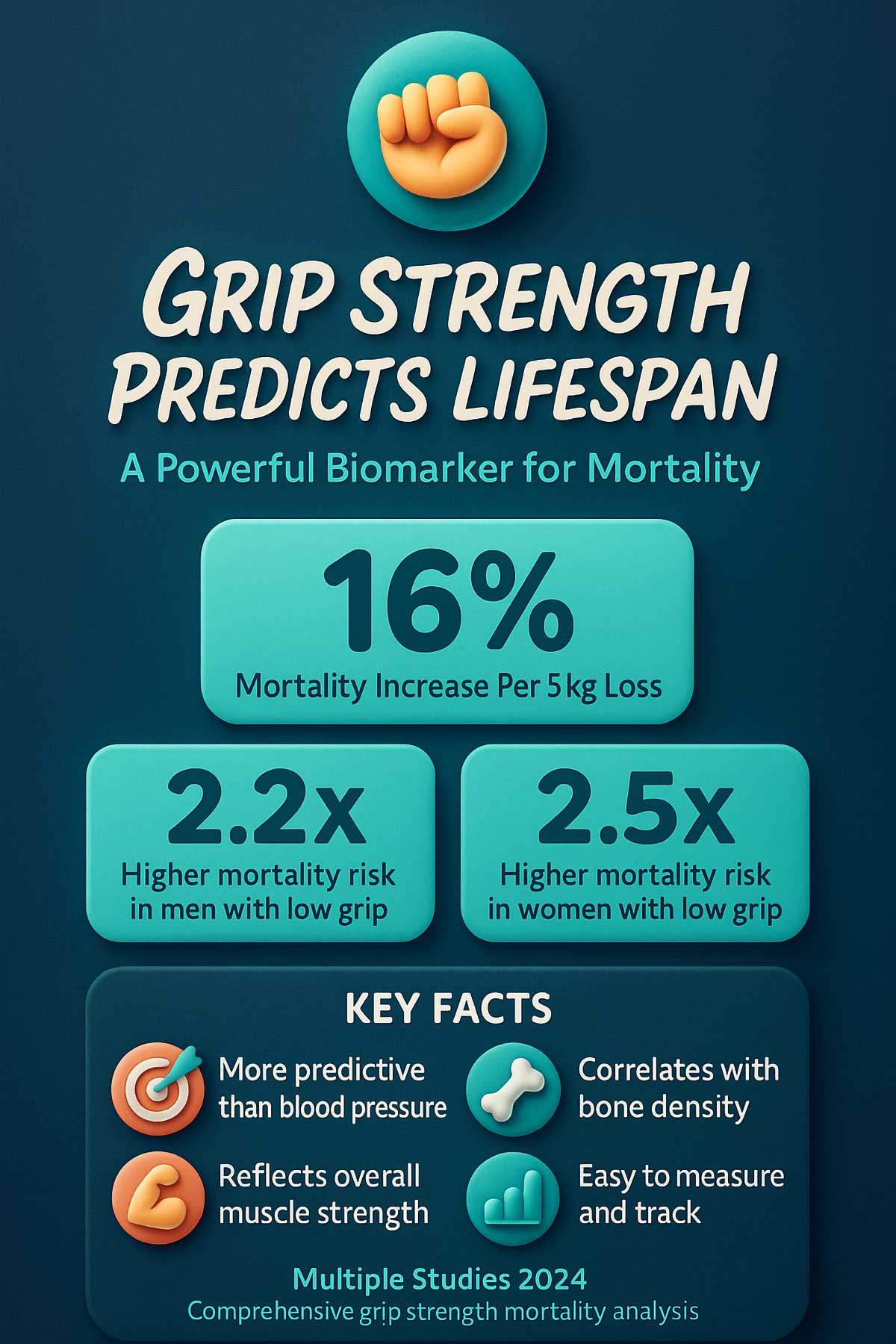
Grip Strength and Mortality Risk
| Age Group | Men (kg) | Women (kg) | Risk if Below |
|---|---|---|---|
| 50-59 | Below 35.5 | Below 20 | 1.45x higher |
| 60-69 | Below 32 | Below 18 | 1.69x higher |
| 70+ | Below 28 | Below 16 | 2.2-2.5x higher |
The farmer’s walk builds that life-saving strength. It also strengthens your core, improves your posture, and makes everyday tasks easier. Carrying groceries. Opening jars. Holding onto handrails.
Bonus: Research shows grip strength correlates with bone mineral density at distant sites like your spine and hips. Strong hands mean strong bones.
How to Do It
- Pick up a weight in each hand (dumbbells, kettlebells, or heavy grocery bags)
- Stand tall with shoulders pulled back
- Tighten your core like you’re bracing for a punch
- Walk forward in a straight line
- Go for 30 seconds or about 20 steps
- Put the weights down and rest
- Repeat
Breathing: Breathe naturally. Don’t hold your breath.
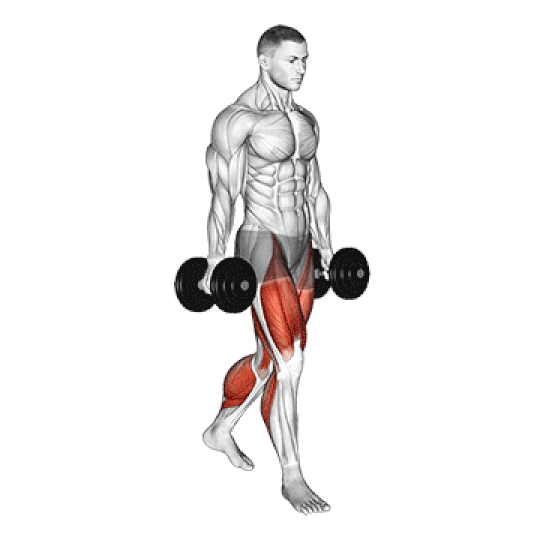
Weight: Start with 5-10 lbs per hand. Progress to 15-20 lbs.
Trainer’s Tip
“Don’t rush. Take slow, careful steps and resist the urge to lean to one side. Imagine you’re walking a tightrope.”
Modify or Progress
- Easier: Carry one weight (suitcase carry), lighter load
- As written: Equal weight in both hands
- Harder: Heavier weights, longer distance
- Advanced: Overhead carry (weight held overhead)
3. The Incline Push-Up
Why It’s Essential for Longevity
This exercise builds the strength to push yourself up if you fall. That’s not dramatic—it’s practical.
Falls are dangerous after 50. A 2009 study in BMC Geriatrics showed that strength training reduces the risk of falls and frailty—two major predictors of early death in older adults.
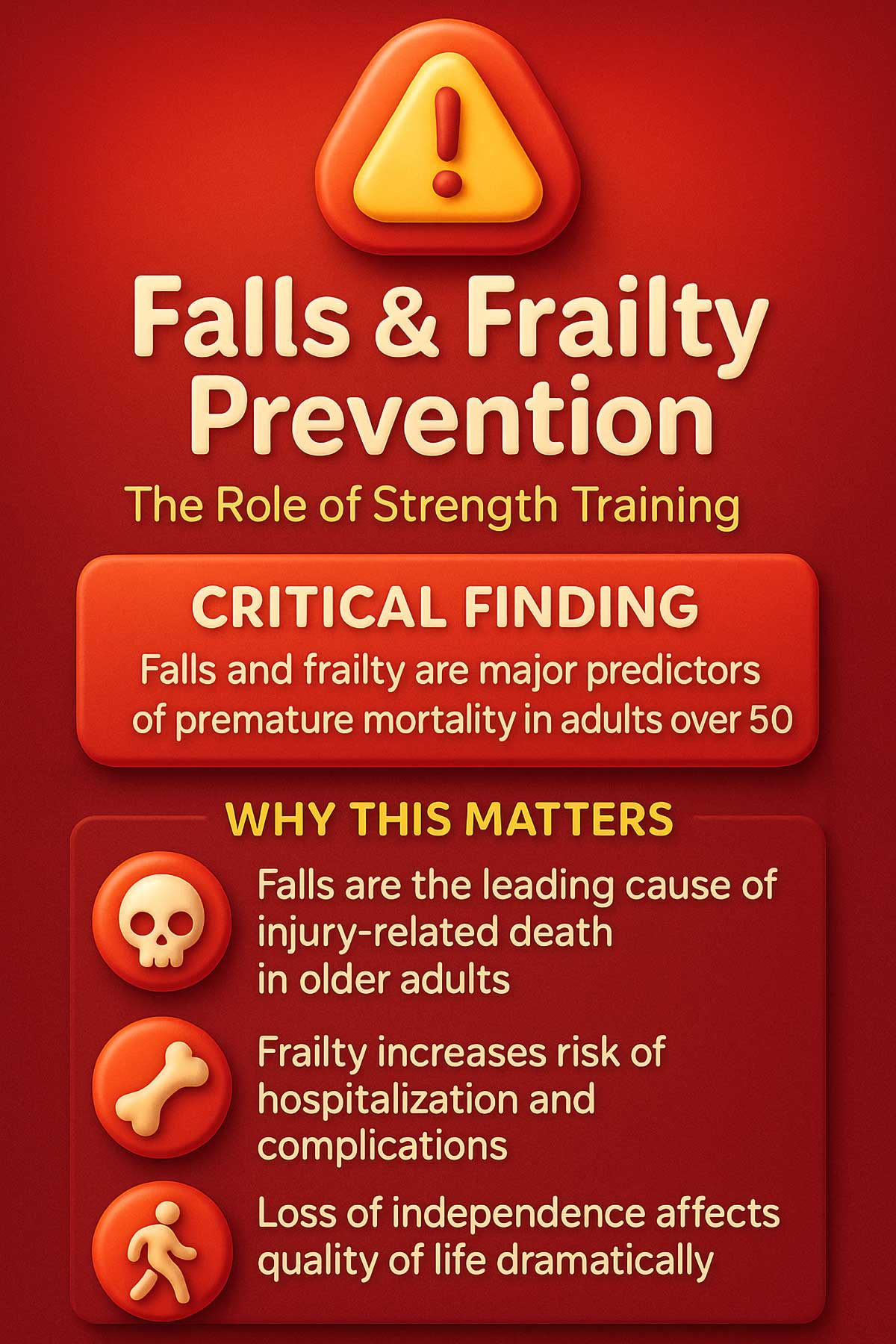
The incline push-up strengthens your chest, shoulders, and core. It’s easier than a floor push-up but just as effective. You control the difficulty by choosing your surface height.
Counter height? Easy. Table height? Moderate. Low bench? Harder.
This is also a full-body stability exercise. Your core works to keep your body rigid. Your legs engage to maintain the plank position.
How to Do It
- Place your hands on a sturdy surface (kitchen counter works well)
- The higher the surface, the easier the exercise
- Walk your feet back so your body forms a straight line from head to heels
- Lower your chest toward the surface
- Keep your elbows at about 45 degrees from your body
- Press back up
- Keep your body rigid the whole time
Breathing: Breathe in as you lower. Breathe out as you press up.
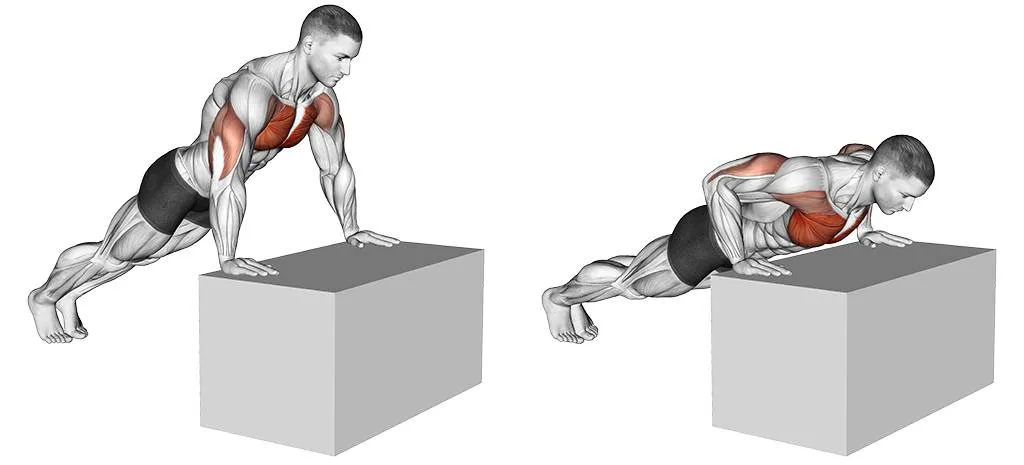
Reps: Start with 8-10 reps. Build to 15-20 before lowering the surface.
Trainer’s Tip
“Keep your body rigid like a plank. Don’t let your hips sag. Squeeze your glutes and abs during the movement.”
Modify or Progress
- Easier: Wall push-up (nearly vertical)
- As written: Counter or table height
- Harder: Low bench or chair
- Advanced: Floor push-up (when ready)
4. The Glute Bridge
Why It’s Essential for Longevity
Your glutes are the biggest, strongest muscles in your body. But modern life makes them weak.
Sitting all day shuts them off. Weak glutes cause back pain. They limit your mobility. They make walking and climbing stairs harder.
Strong glutes protect your lower back. They power your movements. They keep you upright and stable.
A groundbreaking 1994 JAMA study showed that progressive resistance training can reverse age-related muscle loss. The study included people in their 70s and 80s. Even at advanced ages, strength training improved physical function and muscle mass.

The glute bridge is your starting point for rebuilding these critical muscles.
How to Do It
- Lie on your back on a mat or carpet
- Bend your knees and place your feet flat on the floor, hip-width apart
- Your feet should be close enough that you can barely touch your heels with your fingertips
- Squeeze your glutes hard
- Lift your hips off the floor
- Your body should form a straight line from shoulders to knees
- Hold for 2 seconds at the top
- Lower back down with control
Breathing: Breathe out as you lift. Breathe in as you lower.

Reps: Start with 10-12 reps. Build to 20 before adding weight.
Trainer’s Tip
“At the top, imagine you’re balancing a glass of water on your stomach. This helps you keep your core tight and stops you from arching your back.”
Modify or Progress
- Easier: Smaller range of motion (don’t lift as high)
- As written: Bodyweight bridge with 2-second hold
- Harder: Single-leg bridge (advanced)
- Advanced: Weighted bridge (weight on hips)
5. The Bird-Dog
Why It’s Essential for Longevity
Balance isn’t just for yoga teachers. It’s critical for staying safe.
Falls are the leading cause of injury-related death in adults over 65. The ability to maintain balance during movement can literally save your life.
The bird-dog trains your balance and core stability. It teaches your body to stay steady during movement. This helps you walk on uneven ground, reach for objects, and catch yourself if you trip.
It also improves coordination between opposite sides of your body—a skill called cross-body coordination. You use it every time you walk.
A 2012 study in Applied Physiology, Nutrition, and Metabolism found that regular strength training leads to improved insulin sensitivity, reduced body-wide swelling, and better metabolic health. All of these factors are linked to living longer.

How to Do It
- Start on all fours on a mat
- Place your hands directly under your shoulders
- Place your knees directly under your hips
- Keep your back flat like a tabletop
- Slowly extend your right arm straight forward
- At the same time, extend your left leg straight back
- Hold for 5 seconds, keeping your back flat and hips level
- Don’t let your body twist
- Return to start and switch sides
- That’s one rep
Breathing: Breathe naturally throughout. Don’t hold your breath.
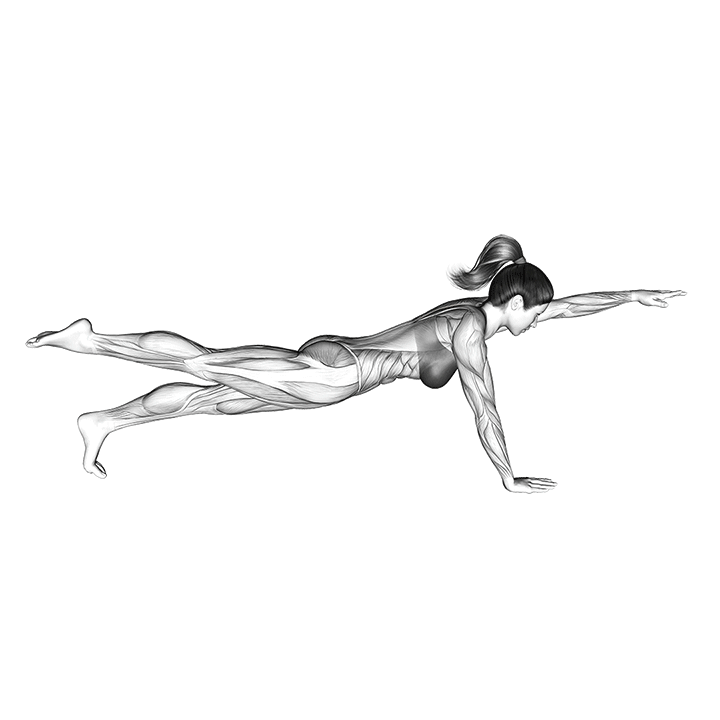
Reps: Start with 6-8 per side. Build to 12-15.
Trainer’s Tip
“Move as if you’re moving through water—slow and with control. The goal is stability, not speed. Point your back toe toward the floor to help keep your hips from rotating.”
Modify or Progress
- Easier: Lift only arm OR leg (not both)
- As written: Opposite arm and leg with 5-second hold
- Harder: 10-second holds, add ankle weight
- Advanced: Bird-dog with knee tap (touch knee to elbow under body)
Workout Timer
5 Exercises for Longevity
Common Mistakes to Avoid
Even simple exercises can cause problems if done wrong. Watch out for these errors:
Holding Your Breath Breathe steadily throughout each exercise. Holding your breath raises blood pressure and makes you dizzy.
Moving Too Fast Speed doesn’t equal strength. Control is what builds muscle and prevents injury.
Skipping the Warm-Up Spend 5 minutes doing light movement before you start. March in place. Do arm circles. Get your blood flowing.
Doing Too Much Too Soon Sore muscles are normal. Sharp pain is not. Start light and progress slowly.
Sacrificing Form to Add Weight Perfect form with 5 lbs beats poor form with 20 lbs every time.
Putting It All Together: Your Weekly Longevity Blueprint
You have the five exercises. Now here’s your exact plan:
Frequency: 2-3 times per week on non-consecutive days (Monday/Thursday or Monday/Wednesday/Friday)
Warm-Up: 5 minutes of light movement
- March in place: 1 minute
- Arm circles: 30 seconds each direction
- Leg swings: 30 seconds each leg
- Hip circles: 30 seconds each direction
- Cat-cow stretches: 1 minute
The Workout:
- Goblet Squat: 2 sets x 8-12 reps
- Farmer’s Walk: 2 sets x 30 seconds
- Incline Push-Up: 2 sets x 8-12 reps
- Glute Bridge: 2 sets x 10-15 reps
- Bird-Dog: 2 sets x 6-10 reps per side
Rest: 60-90 seconds between sets
Cool-Down: 5 minutes of gentle stretching
Total Time: 25-30 minutes
Your Progress Tracking Guide
Follow this 8-week progression plan:
| Week | Sets per Exercise | Reps | Weight/Difficulty | What to Expect |
|---|---|---|---|---|
| 1-2 | 2 sets | 8 reps | Bodyweight/very light | Learning movements, mild soreness |
| 3-4 | 2 sets | 10 reps | Light weight | Exercises feel easier, confidence grows |
| 5-6 | 3 sets | 10 reps | Light weight | Noticeable strength gains |
| 7-8 | 3 sets | 12 reps | Moderate weight | Daily tasks feel easier |
When to Add Weight: Can you complete all sets with good form? Add 2-5 lbs.
When to Add Reps: Hit 12 reps easily? Go for 15 before adding weight.
When to Add Sets: Comfortable with 2 sets? Add a third set.
How to Test Your Progress
Track your improvements with these simple tests. Do them monthly.
Grip Strength Test Place a bathroom scale in a sturdy bag. Squeeze the handles as hard as you can. Record the number. Aim to increase it monthly.
Chair Rise Test Sit in a chair. Stand up and sit down 5 times as fast as you can safely. Time it. Faster = stronger.
Balance Test Stand on one leg with eyes open. Time how long you can hold it. Aim for 30+ seconds per leg.
Functional Check-In
- Can you carry all your groceries in one trip?
- Can you get up from the floor without using your hands?
- Can you play with your grandkids without getting winded?
These real-world measures matter more than any gym test.
What to Expect: Your First 90 Days
Here’s the realistic timeline for results:
Weeks 1-2: Neural Adaptations You’re teaching your brain and muscles to work together. The exercises start to feel more natural. You might not see changes yet, but your body is learning.
Weeks 3-6: Strength Gains This is when you feel the difference. Stairs are easier. You can lift heavier grocery bags. Your balance improves. The mirror might not show much yet, but your body is changing inside.
Weeks 7-12: Visible Changes Your clothes fit differently. You stand taller. People comment on your energy. Daily tasks that used to tire you out barely register now.
A 2010 review in Ageing Research Reviews confirmed this timeline. The researchers found that resistance training increases muscle mass, strength, mobility, and functional independence in adults over 60. The changes directly influence healthy aging.
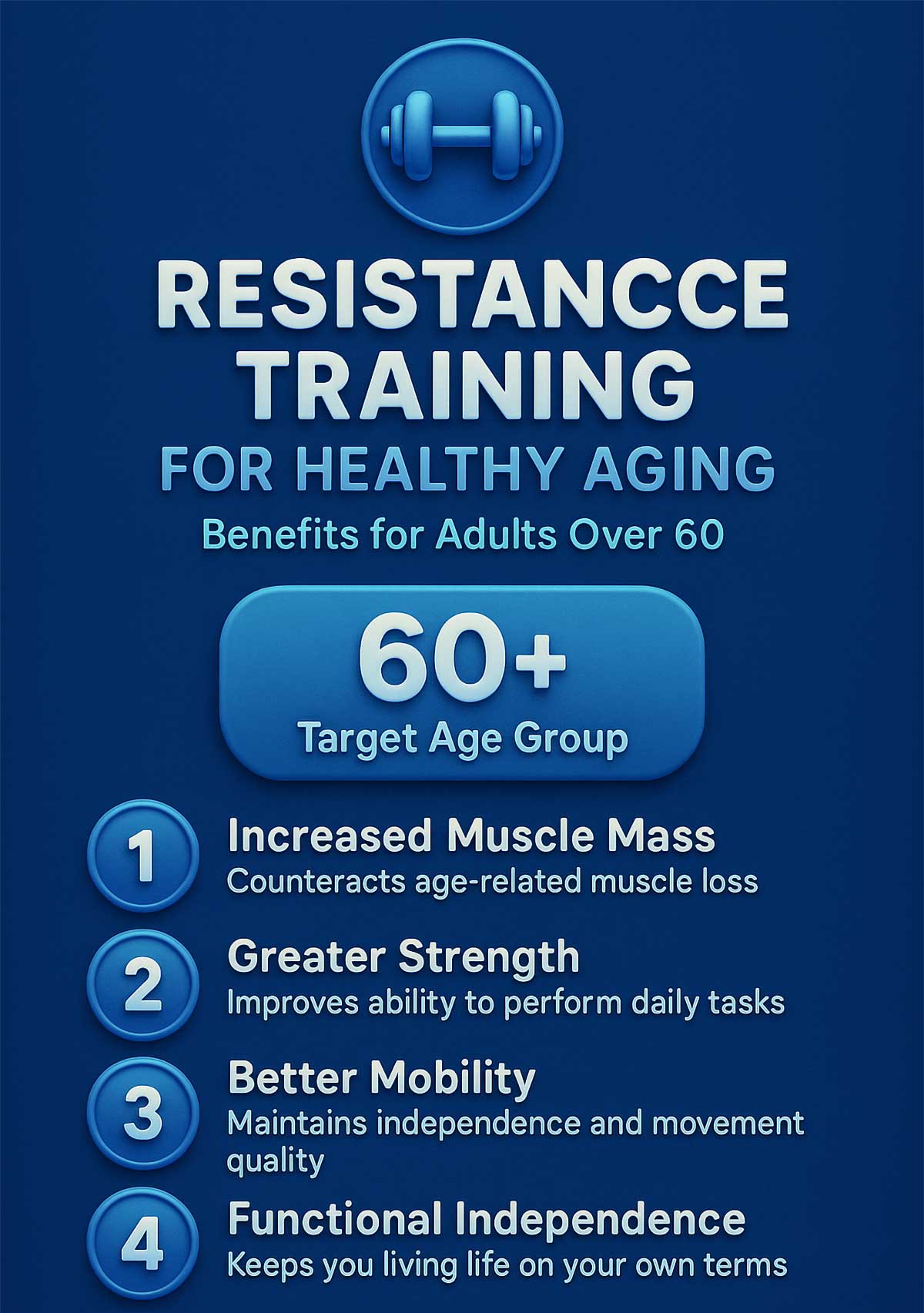
After 90 Days: You’re not done—you’re just getting started. Keep going. The benefits compound over time.
Nutrition to Support Your Strength
Exercise is half the equation. Food is the other half.
Your muscles need protein to repair and grow. After 50, you need more protein than you did at 30.
Protein Goal: Aim for 0.8-1g per pound of body weight daily.
- If you weigh 150 lbs, shoot for 120-150g of protein
Timing Matters: Eat protein within 2 hours after your workout. This is when your muscles are most receptive.
Simple Protein Ideas:
- Greek yogurt with berries (20g)
- 2 eggs with toast (14g)
- Palm-sized chicken breast (25g)
- 1 cup of cottage cheese (25g)
- Black bean soup (15g per cup)
You don’t need supplements. Whole foods work great.
What Real Results Look Like
Here’s what typical results look like after 8-12 weeks of consistent training:
Sarah, 58: “I can carry all my groceries in one trip now. I used to need two or three trips. My back doesn’t hurt anymore either.”
Mike, 65: “My doctor was shocked. My bone density scan improved for the first time in years. He asked what I was doing differently.”
Linda, 72: “I get up from my chair without pushing off with my hands. Such a small thing, but it makes me feel young again.”
Robert, 61: “I’m playing tennis again. I gave it up three years ago because my knees hurt. Now they feel strong.”
These aren’t promises. They’re examples of what’s possible with consistency.
When to See a Doctor
Strength training is safe for most people. But check with your doctor before starting if you have:
- Uncontrolled high blood pressure
- Recent heart attack or stroke
- Unstable angina
- Severe arthritis or joint problems
- History of hernias
- Any condition your doctor monitors regularly
Stop and seek help if you experience:
- Sharp pain during movement
- Chest pain or pressure
- Severe dizziness or lightheadedness
- Unusual shortness of breath
Listen to your body. Good pain (muscle burn, mild soreness) is different from bad pain (sharp, stabbing, joint pain).
Your 3-Step Action Plan
Ready to start? Here’s your simple plan:
Today: Pick one exercise from this list. Do 2 sets of 8 reps. That’s it. You’ve started.
This Week: Complete the full routine once. Block out 30 minutes. Put it on your calendar.
This Month: Establish your 2-3 times per week schedule. Treat these sessions like doctor appointments—non-negotiable.
Quick Reference: Exercise Cheat Sheet
Print this and keep it where you work out:
Goblet Squat
- 2-3 sets x 8-12 reps
- Chest up, sit back to chair
- Breathe out standing up
Farmer’s Walk
- 2 sets x 30 seconds
- Stand tall, tight core
- Slow, steady steps
Incline Push-Up
- 2-3 sets x 8-12 reps
- Body like a plank
- Breathe out pressing up
Glute Bridge
- 2-3 sets x 10-15 reps
- Squeeze glutes hard
- Hold 2 seconds at top
Bird-Dog
- 2 sets x 6-10 per side
- Move slowly
- Keep hips level
Rest 60-90 seconds between sets. Do this 2-3x per week. Progress by adding reps, sets, or weight.
Conclusion
Aging doesn’t have to mean getting weaker. You have more control than you think.
Research from multiple studies confirms the same message: strength training 2-3 times per week can cut your risk of early death by up to 30%. It improves your heart health. It reduces your cancer risk. It protects you from frailty and falls.
But the real benefit isn’t found in any study. It’s the freedom to keep doing what you love. Playing with your grandkids. Traveling. Gardening. Living without limits.
You don’t need a gym. You don’t need fancy equipment. You don’t need to be fit already.
You just need to start.
Pick one exercise from this list. Do it today. Then do it again in two days.
Consistency beats intensity every time.
FAQs
What are the 5 Ps of longevity?
Purpose, Physical activity, Plant-based nutrition, Positive relationships, and Peace of mind. This article focuses on physical activity—specifically strength training—which is one of the most powerful longevity factors you can control.
What are the only 5 exercises you’ll ever need?
For longevity after 50, the five essential moves are: goblet squats (lower body strength), farmer’s walks (grip and core), incline push-ups (upper body), glute bridges (posterior chain), and bird-dogs (balance and stability). These cover all major movement patterns.
What is the number one exercise for seniors?
The squat wins. It maintains your ability to get up from chairs, toilets, and cars—movements essential for independence. It builds leg strength, prevents falls, and keeps you mobile.
What are the best exercises for 60 year olds?
The same five exercises in this article work perfectly. They’re low-impact, joint-friendly, and scalable. Start with easier versions and progress as you get stronger.
How much exercise per day for a 60 year old woman?
Aim for 25-30 minutes of strength training 2-3 times per week, plus daily movement like walking. You don’t need hours at the gym. Consistency beats duration.
How often should I do a 5 12 30?
If you’re doing these 5 exercises (2-3 sets of 12 reps in 30 minutes), stick to 2-3 times per week. Your muscles need rest days to rebuild and get stronger.
Are these exercises a day enough?
Yes. These five moves work your entire body. Combined with daily walking or light activity, this is enough to build strength, reduce mortality risk, and maintain independence.
Can you transform your body in 3 months?
You’ll see significant functional improvements in 90 days—more strength, better balance, easier daily tasks. Visible muscle changes take longer, but you’ll feel the difference much sooner.
What is the #1 predictor of longevity?
Grip strength is one of the most powerful predictors. It correlates with overall muscle strength, bone density, and mortality risk. That’s why the farmer’s walk is so important.
What increases life expectancy the most?
Multiple studies show strength training 2-3 times per week reduces all-cause mortality by 20-30%. Combined with good nutrition, sleep, and social connections, exercise is your best longevity tool.
How long until I see results?
You’ll feel stronger in 3-4 weeks. Visible changes take 8-12 weeks. Functional improvements (carrying groceries, climbing stairs) happen first.
What if I can’t do even the beginner version?
Start with wall push-ups instead of incline push-ups. Do partial squats instead of full ones. Hold a plank instead of bird-dogs. Everyone starts somewhere.
Can I do this if I have arthritis, bad knees, or back pain?
Often, yes. Strength training can help these conditions. Start with very light weights and small movements. Listen to your body. Work with your doctor if pain persists.
Should I feel sore?
Some soreness 24-48 hours after working out is normal. It’s called delayed onset muscle soreness. Sharp pain during exercise is not normal.
What are signs of over exercising?
Constant fatigue, declining performance, trouble sleeping, persistent muscle soreness, frequent illness, loss of motivation, or irritability. If you experience these, take extra rest days.
Can I do these exercises every day?
No. Your muscles need rest to get stronger. Stick to 2-3 times per week with at least one day off between sessions.
What if I miss a week?
Life happens. Jump back in where you left off. Don’t try to make up for lost time. Consistency over weeks and months matters more than perfection.


